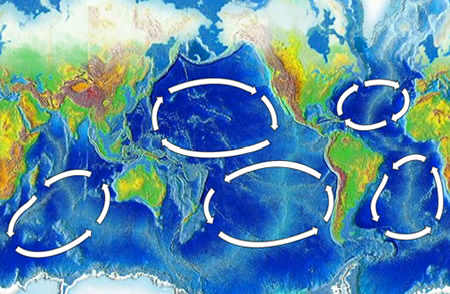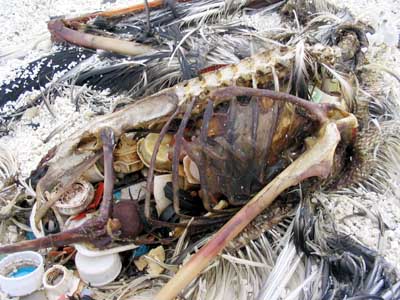Imagine a man-made “garbage patch” that is twice the size of Texas, is composed man-made debris, 90% of which is plastic, and floats in the ocean. No, it’s not a sci-fi story about the eighth continent, but something very real, known as the Great Pacific (or Eastern) Garbage Patch or the Pacific Trash Vortex, that is trapped by currents in the North Pacific Ocean between California and Hawaii. And it’s not the only one.
Because such trash islands are continually growing and their contents are suspended at or just beneath the surface of the oceans, they are hard to measure. But their horrific impacts on marine life are becoming disturbingly obvious. Marine mammals, fish, seabirds, and other animals are often ensnared in the nylon fish nets and six-pack rings that abound in the garbage patches, and they are also in danger of choking on things like balloons, bottle caps, and plastic bags and wrappers. Even if they don’t choke, ingestion of such plastics can result in slow starvation due to blockage of the digestive system, genetic problems, and slow poisoning due to the build up of pollutants in the plastic debris.
Although the Great Pacific Garbage Patch is the most widely publicized trash island, the Atlantic Ocean has one in its Sargasso Sea, and there are five other major ones as well. All of them are caused by currents that meet and begin to rotate, creating a “gyre” or funnel for anything in the water; wind-driven surface currents then gradually move the floating debris toward the center, concentrating it and creating an island of garbage.
The existence of the Eastern Garbage Patch was predicted in a 1988 paper published by the National Oceanic and Atmospheric Administration, and its existence was verified in 1997 and widely publicized thereafter by Charles Moore, a sea captain and ocean researcher. In one of his articles, Moore reported that there are six pounds of plastic floating in the North Pacific subtropical gyre for every pound of naturally occurring zooplankton (Moore et al. A comparison of plastic and plankton in the North Pacific central gyre. Marine Pollution Bulletin, v.42, n.12, Dec01). In his studies, Moore found that the majority of the plastic in the world’s oceans is made up of billions of pounds of tiny plastic pellets called nurdles, a byproduct of plastics manufacturing. According to a study by the US Environmental Protection Agency, nearly sixty billion pounds of these plastic pellets were produced in 1992 alone, and nothing has been done to date to regulate their disposal.
Ironically, our plastic trash is going full circle, although you might say that the snake is eating its own tail. Plastics have their origin in the ancient marine organisms whose deposits resulted in the petroleum we now use to create plastic, the detritus of which is dumped into our oceans and is now competing with the very marine life forms that made the plastic possible. Attempts to clean up our marine trash have failed because there is simply too much of it over too large of an area to make such attempts significant. Ultimately, mankind needs to stop fouling its own nest and to begin enacting strict recycling and disposal policies, cleaning up the world’s beaches, and reducing the amount of trash going into the world’s oceans.
Editor’s Note: For more on this subject see , http://en.wikipedia.org/wiki/Great_Pacific_Garbage_Patch, and http://thetyee.ca/Views/2006/07/26/PlasticSea.
Article by Bill Norrington





